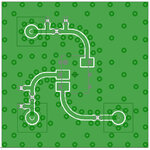skatefast08
Full Member level 4

Anyway, your "expert" on YT is stupidly wrong.
https://www.youtube.com/watch?v=SwNb0ndIT5k&t=354s
starting (2:25 - 2:42), they are Rogers Corp. ACS.
- - - Updated - - -
You forget working at 2.4GHz.Everything is critical at RF.
Typical GND connection of a stub or grounded components should be as follows.
View attachment 146339
is this better?
https://imgur.com/a/ayc7bf4
, some of the 0402 components I couldn't seem to get 5 vias surrounded, only 4.






